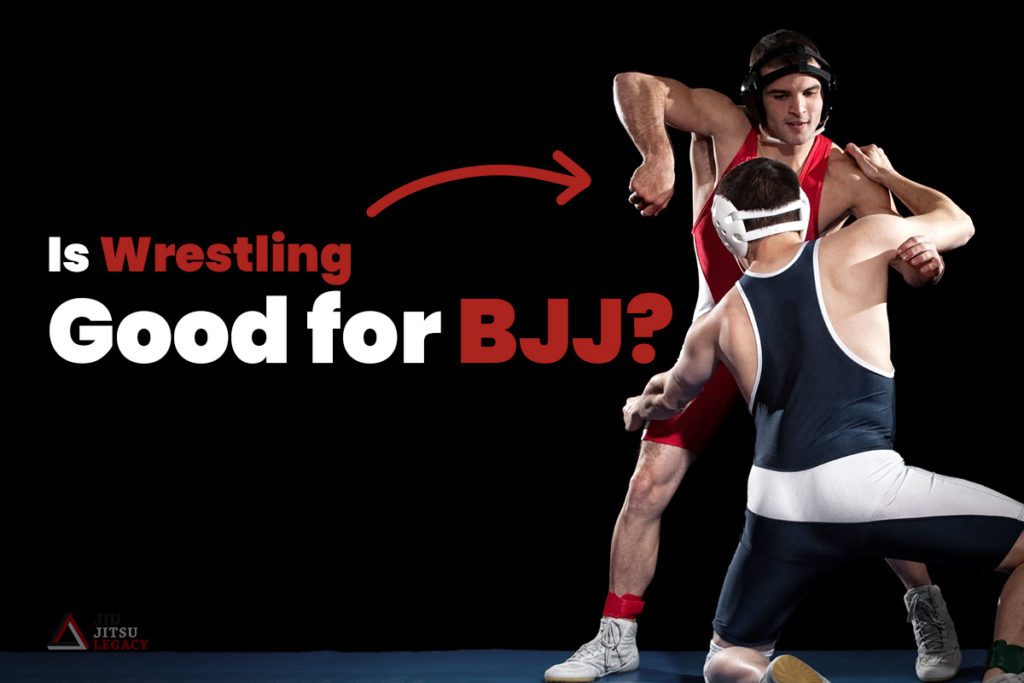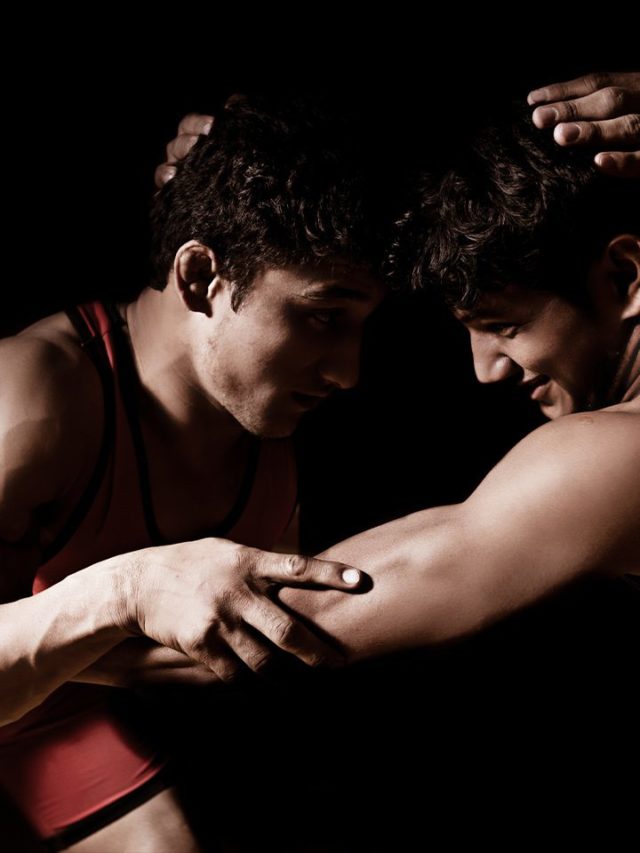What do you think of when you read wrestling for BJJ? Most people that have been involved even shortly in Jiu Jitsu immediately start thinking about takedowns. Those that are a bit deeper into the grappling lifestyle might also consider pinning techniques.
Well, today I am going to attempt to introduce wrestling moves for Jiu Jitsu that have nothing to do with either takedowns or pins. Today we’ll talk about using wrestling for BJJ for control.
Is Wrestling Good For BJJ?

I think most of you already know the answer to this question. If you’ve ever rolled with a wrestler, especially one with even a little bit of experience cross-training BJJ, you already know that wrestling works. Even experienced black belts often have a difficult time dealing with an explosive wrestler on the mats.
So, the answer would be a resounding yes, wrestling is great for BJJ. There is only one problem. If you’re going to train both wrestling and BJJ full time, you’re probably a professional fighter or somebody with a lot of time and energy. Even under the best of circumstances, training both with equal attention is difficult, if not impossible for the average Joe.
Training wrestling for BJJ, on the other hand, is a very smart way to quickly and effectively improve your skills in Jiu Jitsu. After all, wrestling is a grappling style as old as humanity itself. With Brazilian Jiu Jitsu being barely a century old, and wide open to integrating techniques from other grappling martial arts, adding wrestling seems like an obvious choice.
Integrating Wrestling Into Your Jiu Jitsu Game
So, how do you go about introducing wrestling for BJJ to your game? First of all, you don’t have to go and join a wrestling club. In fact, that might just turn out to be a bad idea, given that modern-day wrestling training follows a training system that is far from optimal for BJJ athletes.
Getting privates with a wrestler who also trains BJJ, looking at instructionals and reading articles, or better yet, joining a BJJ gym that has wrestling for BJJ classes in the curriculum are great options for adding wrestling to your BJJ game.
The bottom line is that you should be looking at wrestling concepts and moves that you can add immediately into your game, rather than trying to master wrestling as a sport. As one of the oldest grappling systems in the world, there are many nuggets of wrestling wisdom that might end up fitting your game better than BJJ solutions would.
Wrestling For BJJ: Going Beyond Takedowns

I will keep my attention on only two aspects of wrestling for BJJ today which I find to be extremely useful in terms of controlling opponents: Nelsons and leg rides.
Both are transitional moves in wrestling, used to open up a downed opponent’s defenses against pins. As such, they offer immense opportunities for BJJ athletes, given the positional variability and openness of the Jiu Jitsu game.
Nelsons
Nelsons are age-old wrestling control techniques that work by gripping an opponent’s neck, while also integrating one or both their arms in the hold. In fact, the Full Nelson hold is one of the oldest grappling and law enforcement holds, easily recognizable even to non-martial artists. It has the unfortunate distinction of being illegal under nearly all grappling rulesets, due to the neck-cranking nature of the position.
Unlike the Full Nelson though, the other Nelson variations (quarter, half, and three-quarter Nelson) are all fair game in Jiu Jitsu.
The best use of Nelsons in BJJ, in my opinion, is to deal with people attempting to turtle up, or those looking to start a scramble in hope of getting out of your reach.
Quarter Nelson
The Quarter Nelson position involves you sneaking an arm underneath your opponent’s armpit and using it to reinforce a grip on the back of their neck with the other arm by establishing a figure four grip (similar to a Kimura grip).
The move offers insane control over your opponent by giving you access to their neck and shoulder. You can use it to tilt or roll over turtled-up opponents, get to side control, or even pass different half guards. On top of it all, you can immediately use the arm configuration to set up front headlock chokes like D’arces and neckties.
Half Nelson
The half Nelson extends the control you have over the opponent’s neck and shoulder. For this variation, you sneak your far arm underneath a turtled opponent’s armpit and over the back of their neck.
You can use the move to open up any turtle or half guard, or prevent scrambles from happening as you’re looking to take somebody’s back. A move I particularly like transitioning to from the half Nelson is the North South choke.
Three-Quarter Nelson
The three-quarter Nelson hold is my particular favorite when it comes to wrestling for BJJ. It starts with a half Nelson, and then your free arm swims underneath your opponent’s neck and establishes a palm-to-palm grip.
This move provides more control over your opponent’s shoulder girdle than anything else in grappling, while at the same time giving you the option to maneuver. It makes breaking anyone down to their back extremely easy from a variety of positions and offers cool submission options like the boltcutter choke.
Leg Rides
Leg rides are extremely versatile moves that should be in every BJJ back taker‘s arsenal. They open up a different aspect of leg control which will keep opponents confused and dazzled as you make your way through to your favorite positions.
Ankle Ride
An old-school wrestling move that works even against modern-day turtle defenses. The original wrestling move involves trapping a turtled up opponent’s ankle with the back of your knee (in between your calf and hamstring). This makes it impossible for the bottom person to stay in turtle, but also limits their ability to re-guard or disengage.
With the leg trapped as described, simply throwing yourself forward (belly down) will open up most turtles. The power of the move comes from keeping the leg trapped once you’re on top and riding it until you get your desired BJJ control position or pin in wrestling.
As long as you stay focused on keeping your heel as high over your butt as possible you’ll be able to maintain any leg ride.
Inside Leg Ride
The inside leg ride is essentially a hook on one of the opponent’s legs, exactly as if you were setting up the truck position.
Instead of going for the truck position (which was originally inspired by this move), you’ll look to drop back down and manipulate your opponent’s legs (some cool and very painful catch wrestling-style heel hooks are available from there) or you could once again take the opponent for a ride by throwing yourself forward.
Leg rides like the inside leg and ankle ride are awesome in breaking down the turtle, keeping people from turtling up, or maintaining easy hip control until you set up back control or throw in a Nelson to do whatever upper body attacks you want.
Final Thoughts
Wrestling for BJJ is not all about takedowns and pins. Transitional control positions like Nelsons and leg rides are incredibly useful when it comes to connecting Jiu Jitsu positions. They offer a different take on shoulder and/or hip control that you can use to improve any type of BJJ game that you desire.

Ogi is a black belt that does Jiu Jitsu full time and is very passionate about anything grappling-related.
He is also the head coach of Enso Jiu Jitsu in Macedonia and an aspiring Globetrotter.

